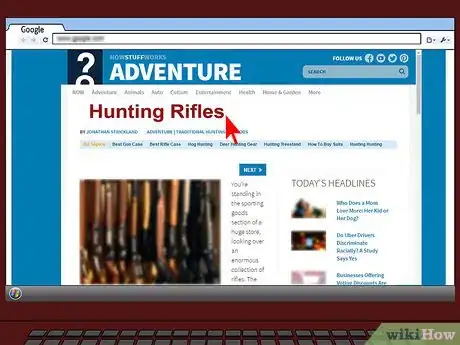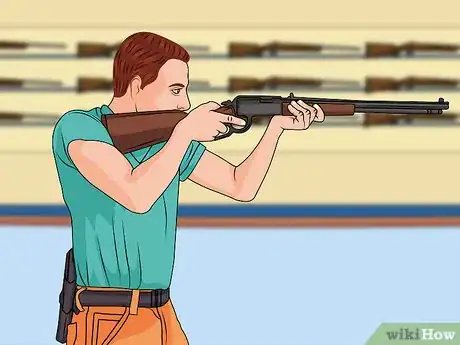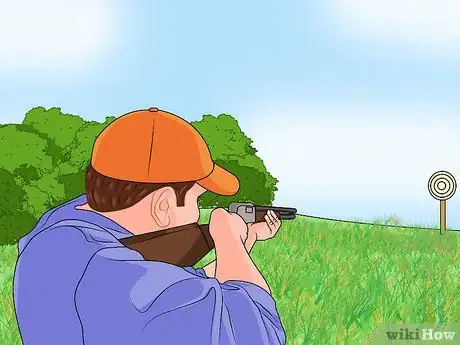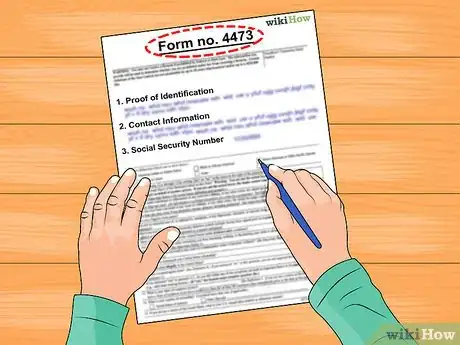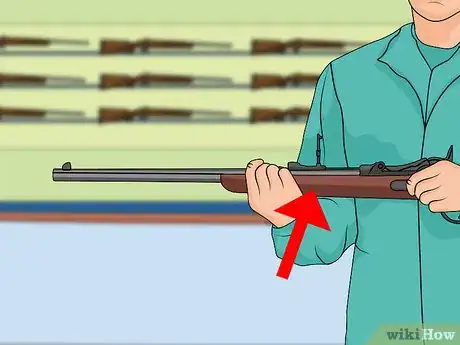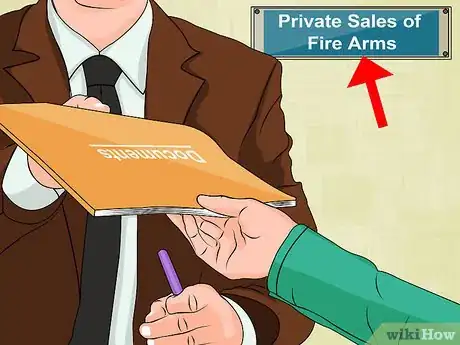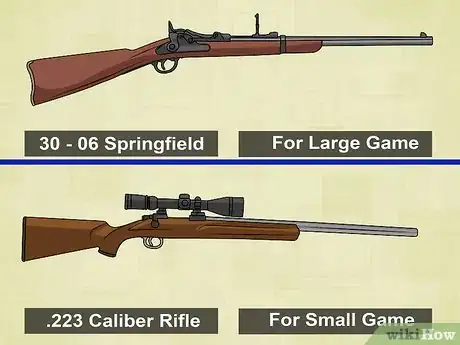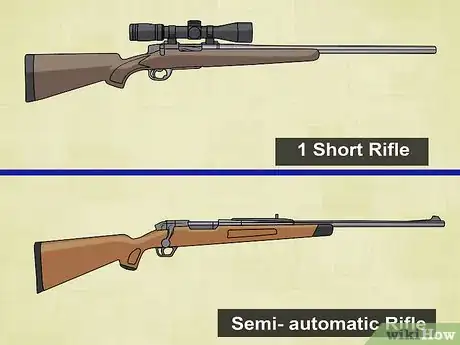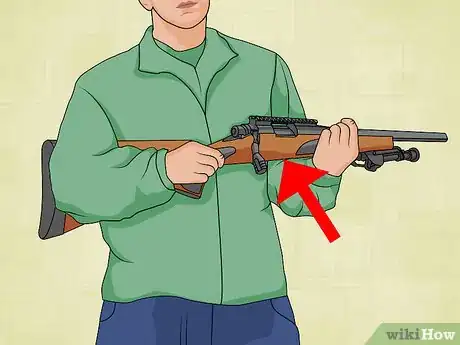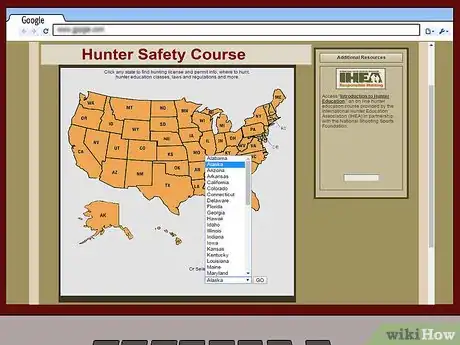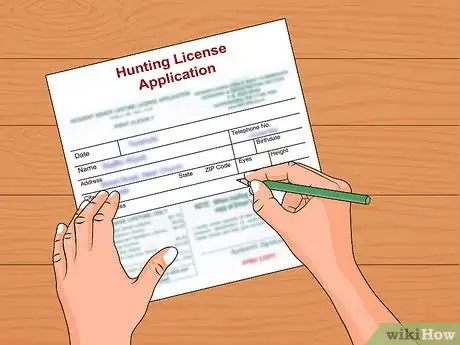This article was co-authored by wikiHow Staff. Our trained team of editors and researchers validate articles for accuracy and comprehensiveness. wikiHow's Content Management Team carefully monitors the work from our editorial staff to ensure that each article is backed by trusted research and meets our high quality standards.
There are 7 references cited in this article, which can be found at the bottom of the page.
This article has been viewed 59,702 times.
Learn more...
Purchasing a hunting rifle entails two important factors: choosing the right rifle for you and ensuring you adhere to all the pertinent hunting and firearm laws in the area that you live. A good deal of this article assumes you are purchasing a firearm within the United States. Those shopping for a hunting rifle in other countries should research the laws pertaining to purchasing and owning firearms in your area.
Steps
Purchasing a Hunting Rifle
-
1Choose a rifle before going to the store. Pricing on hunting rifles can vary greatly depending on the region you shop in and the store you choose to purchase the rifle from. Arm yourself with as much information about the rifle you want as you can before walking into a store to make a purchase. It can be easy to overpay for a rifle if you aren’t aware of its fair market price.
- Some firearms stores operate similarly to car dealerships in that the prices are set a bit high, but you may be able to talk them down. This is particularly true for used firearms.
- Being knowledgeable about the purchase beforehand will help ensure you get a good price.
-
2Ask to hold the rifle before purchasing it. You may have your heart set on a specific rifle on paper, but when you seat it in your shoulder you realize that it feels all wrong. Being able to hold and maneuver your rifle comfortably is imperative to hunting. Not only do you need to be able to establish a comfortable natural point of aim, but the weight must be something you can easily carry and manage while aiming. If the weapon is not comfortable or too heavy, you may need to reassess your choices.[1]
- Always check to make sure the weapon is not loaded before pointing it in any direction.
- Seat the rifle in your shoulder and raise it so you can see where you cheek falls on the stock and if you are able to support the weight of the rifle comfortably. Make sure you do so in a direction where no one is standing.
Advertisement -
3Test fire the rifle if possible. Some firearm dealers have on site shooting ranges that you can use to test fire weapons. While you likely will not be able to fire the specific rifle you intend to purchase (if it’s new) you may be able to fire the same make and model rifle to get a feel for the weight, ease of use, and recoil.
- You can also ask for a demonstration on how to properly load and unload the rifle.
- Pay close attention to the recoil of the rifle. If it hurts to fire, you may want to choose a lower caliber weapon.
-
4Undergo a background check. When you’ve chosen the right rifle for you, you will need to complete a Form 4473. Depending on the location you purchase your hunting rifle, you may need to complete it on paper or using a computer. The Form 4473 contains sixteen questions relating to your background, history of drug use and criminal history. You will also need to provide proof of identification, contact information and your Social Security number. The result may come back approved, delayed or denied. [2]
- The information you provide will be run through the federal database by NCIS to assess if you are legally permitted to purchase a firearm.
- In some states, you can take a hunting rifle home the day of purchase with an approved background check.
- If your background check is delayed, you will not be able to pick up your weapon until it has come back approved.
-
5Consider purchasing optics for your hunting rifle. If the hunting rifle you choose does not come with a scope, you may want to consider purchasing one. While some hunters prefer to hunt using “iron sights,” or the metal front sight tip and rear sight aperture on the barrel, most prefer using optics that provide some degree of magnification. Choose a rifle scope based on the distances you intend to hunt from and the type of rifle you purchased.[3]
- Rifle scopes rated at 3x9 are the most common choices for beginner and experienced hunters alike.
- The numbers in a rifle scope magnification rating represent the range it can magnify. 3X9 scopes can be set to three times or up to nine times magnification.
-
6Return to pick up your hunting rifle. Depending on where you live and the background check process, you may need to wait anywhere from one to ten days before picking up your rifle. Upon the purchase of the rifle, the firearm store will notify you of how long you will need to wait before returning. After the prescribed period of time, you may come back with the receipt and take ownership of the weapon.[4]
- Hawaii requires a wait of fourteen days, but all other states in the U.S. require ten days or fewer.
- In some states, having a license to carry a concealed weapon precludes you from the waiting period.
-
7Submit documentation on private sales when required. If you purchased your firearm from another person rather than a business, you should ensure you are adhering to the laws in the area you live in. Eight states in the United States require background checks and other documentation to be submitted for private sales of firearms.[5]
- While the responsibility is on the seller to ensure they adhere to state and federal laws when selling you a firearm, you should be aware of the legal requirements as well.
Choosing the Right Type of Hunting Rifle
-
1Determine what you intend to hunt. Different types of game often require different types of firearms to hunt effectively. Larger game such as moose or bear will require a higher caliber weapon. Small game like rabbits or squirrels require a smaller caliber weapon to prevent damaging the meat too much to eat.[6]
- For most medium to large game, a rifle designed to shoot .30-06 Springfield, .308 Winchester or .270 Winchester ammunition are all good choices.
- For small game, .22 or .223 caliber rifles are a better choice.
-
2Choose the right rifle action for you. Rifle action is the term used to describe how a rifle ejects a fired cartridge and loads a new one. There are a number of designs to choose from when it comes to rifle action, including breach loading, bolt-action, lever-action, semi-automatic and more. First, determine if you would like your rifle to fire a single shot before manually loading a new cartridge or multiple shots. Then choose a form of action within those two categories.[7]
- Bolt-action, breach loader, and trap door action rifles all fire one shot before the hunter must take action to load the next round.
- Semi-automatic rifles can continually fire until the magazine or clip runs out of ammunition.
- Some hunters prefer the increased challenge of single shot rifles, but semi-automatic rifles are often a better choice for beginners.
-
3Pick a rifle made from the right materials. Hunting rifles come in a broad range of price points. While it’s possible to purchase a good quality hunting rifle for fairly little, you often get what you pay for in terms of the materials the rifle is made of. Lower quality materials will require more maintenance and upkeep to prevent them from rusting or becoming unserviceable, while higher quality materials will be able to fire more rounds and last longer without service or replacement.[8]
- Stainless steel barrels and other rifle components can raise the price of the rifle, but offer a higher degree of reliability and resistance to rust.
- Carbon steel is often used in lower cost hunting rifles. While these are not necessarily a bad option, they will require more upkeep to prevent them from rusting.
- Stocks made from wood and fiberglass are both good choices. Walnut tends to be the most durable option in wood stocks.
-
4Read reviews online. Once you have determined the caliber and action of the rifle as well as the materials you want it to be made from, go online and do some research into rifles that fit your qualifications. There are many rifle makers that offer a wide variety in hunting rifles. Like cars, some designs can be more reliable than others and certain makes and models may have issues you should be aware of.[9]
- Read reviews you find about rifles that fit your criteria and assess the rifle’s positive and negative attributes.
- Like cars, it can be difficult to find one rifle that does everything well. A racecar is not good off road and trucks tend not to win races. Look for a rifle that does what you want well, but understand that it may be difficult to find the “perfect” rifle.
Adhering to Hunting and Firearm Laws
-
1Take a hunter safety course. Many places require hunter to attend a hunter safety course before they are eligible to purchase a firearm or apply for a hunting license. If your area does not require it, the information and experience you can gain in a hunter safety course is still well worth the time and investment.[10]
- You can find hunter safety courses in your area on websites like http://huntinfo.org/
- Hunter safety courses often introduce you to different types of hunting rifles. This will give you the opportunity to experience different rifles before making a purchase.
-
2Apply for a firearm permit. In some areas, you must apply for a firearm license in order to purchase any sort of firearm or ammunition. Go to the website for your local government to research what the requirements are in your area. Many places have different levels of firearm permits ranging from simply owning a firearm to concealed carry permits.
- Apply for the level of firearm license you need to purchase a hunting rifle.
- You will likely be subjected to a background check and brief questionnaire in order to apply.
-
3Research laws pertaining to second-hand gun sales in your area. You may choose to purchase your first hunting rifle second hand in order to reduce costs. While this is a common practice among hunters, each state has different laws governing the sale of firearms between private parties. You may need to have a licensed firearm dealer oversee the exchange or provide documentation to the local government.
- Some states have specific forms to complete when selling a firearm between private parties.
- In some places, you will need to undergo a federal background check in order to buy a firearm from another private party just as you would at a store.
-
4Apply for a hunting license. In order to go hunting, you will need a hunting license issued by the state you will be hunting in. Depending on the game you choose to hunt, you will likely also need to purchase tags indicating how many of that animal you are permitted to hunt.
- Many places require the completion of a hunter’s safety course to apply for a hunting license.
- You can often apply for and purchase your hunting license at hunting retail stores.
References
- ↑ https://www.outdoorlife.com/one-gun-to-hunt-everything/
- ↑ https://www.thetrace.org/2015/07/background-checks-nics-guns-dylann-roof-charleston-church-shooting/amp/
- ↑ http://www.opticsplanet.com/howto/how-to-choose-a-riflescope.html
- ↑ http://smartgunlaws.org/gun-laws/policy-areas/gun-dealer-sales/waiting-periods/
- ↑ http://smartgunlaws.org/gun-laws/policy-areas/background-checks/universal-background-checks/
- ↑ http://schooloftrades.edu/gunsmiths-guide-5-tips-for-choosing-the-best-hunting-rifle
- ↑ http://schooloftrades.edu/gunsmiths-guide-5-tips-for-choosing-the-best-hunting-rifle
- ↑ http://schooloftrades.edu/gunsmiths-guide-5-tips-for-choosing-the-best-hunting-rifle
- ↑ http://schooloftrades.edu/gunsmiths-guide-5-tips-for-choosing-the-best-hunting-rifle
